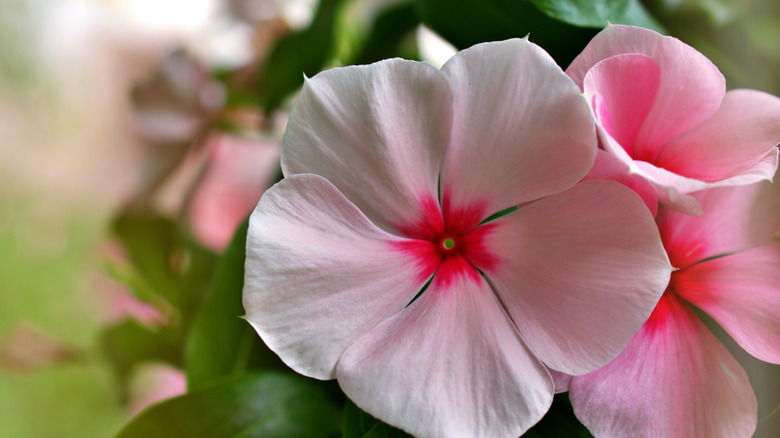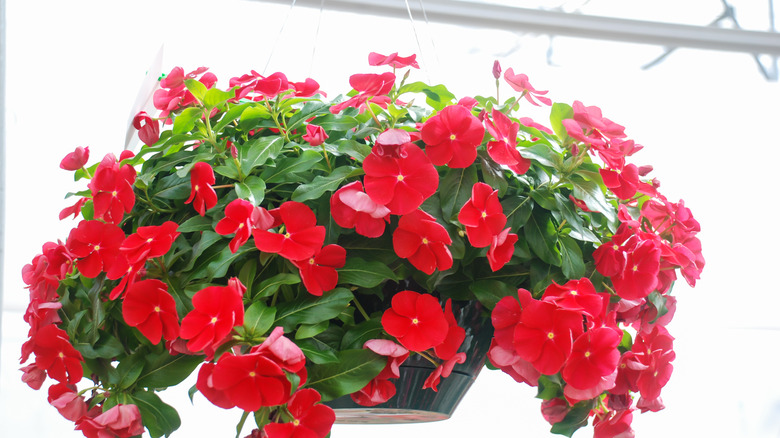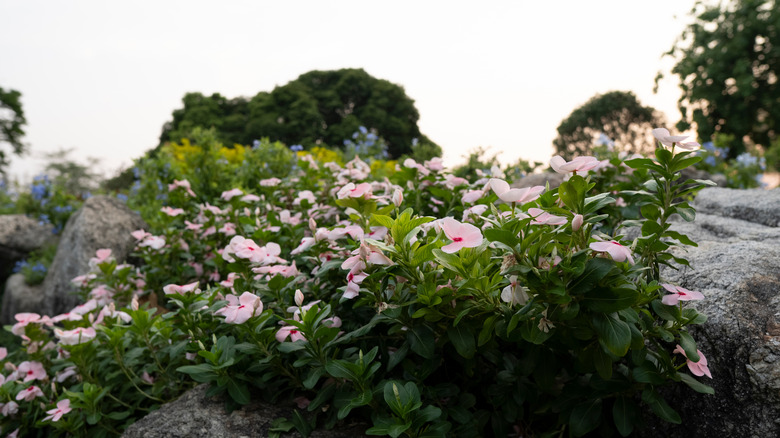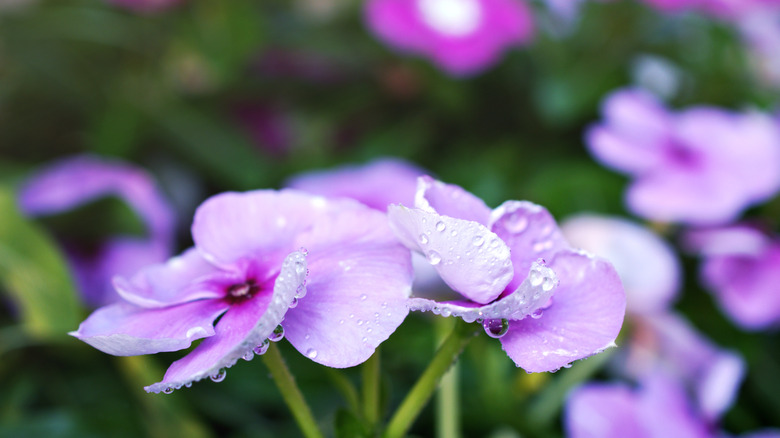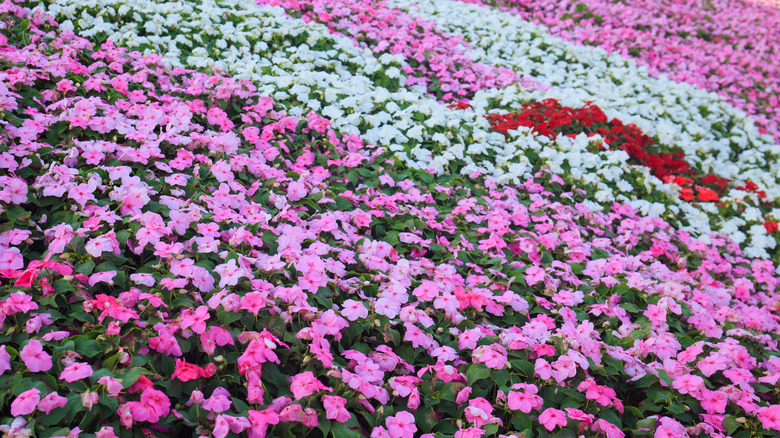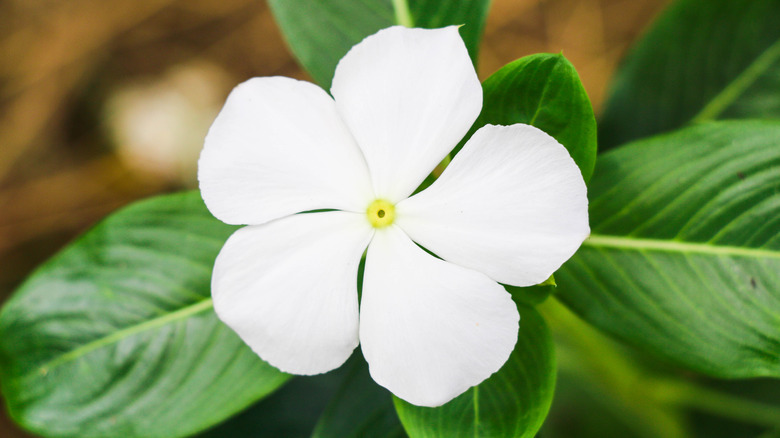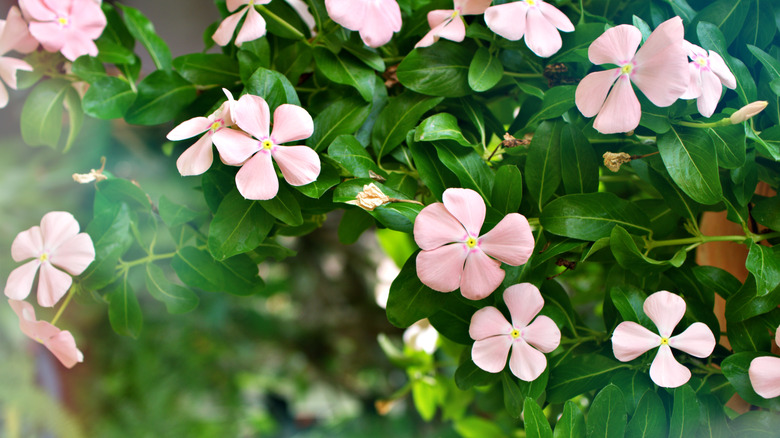How To Grow And Take Care Of Annual Vinca Plants
Annual vinca (Catharanthus roseus), also referred to as Madagascar periwinkle, is a sun-loving plant favored for its reliable, vibrant flowers during what can be withering conditions for much vegetation. Perennial native to Madagascar and its subtropical climate, the plant thrives in heat. A tolerance for drought makes it a popular choice among southern gardeners; however, Madagascar periwinkle is grown successfully as an annual in most continental U.S., in USDA zones 4 through 10. Sometimes confused with evergreen perennials — common periwinkle (Vinca minor) or greater periwinkle (Vinca major) — annual vinca has an upright span double that of common and greater periwinkle and does not follow its tendency to be invasive. It, fortunately, lacks the sweet, ant-attracting nectar of the other species it resembles and is occasionally mistaken for, according to The Spruce, but draws pollinating butterflies. Whereas common periwinkle is a delightful menu item for deer and loves shade, annual vinca prefers sun and is deer resistant.
This spreading annual displays a profusion of flowers offset by glossy green foliage; each flower presents five overlapping petals and a central, contrasting star. It's a beautiful bed and border plant that works equally well in hanging baskets or container gardens. Better Homes & Gardens explains that Madagascar periwinkle is available in abundant color options, from pastels to bold hues, with a trailing or upright habit. Along with drought and pest resistance, it's a sure bet for bringing low-maintenance liveliness and brightness to the summer landscape.
How to use annual vinca in the garden
Use the upright, creeping Madagascar periwinkle in mass planting beds, xeriscapes, and borders. They are fast-growing and will spread equally wide and tall, generally 6 to 18 inches. Combine them with other partial-shade to partial-sun plants that prefer dry and well-draining soil. They will bloom all summer long in the right conditions, with pink, white, red, and purple flowers that range from the palest to the richest hues. The Spruce suggests companion planting with flowers in shades that match the center eye to emphasize their graphic nature.
Trailing varieties are perfect for hanging baskets and flower boxes. Imagine an Independence Day container with Catharanthus 'Pacifica Burgundy Halo' — dark pink-red petals and a white star — with spiky blue Veronica and brilliant white candytuft. Or compliment the shiny, oblong leaves with larger or textured foliage. Look to annual vinca to add sweet and easy-care curb appeal to your home and color to back-yard garden beds.
How to grow annual vinca
Purchase healthy plants from a nursery in early summer and a bit sooner in southern states. The Spruce explains that waiting until night-time temperatures average 60°F is prudent — around the same time when tomato transplants are set out. Gather enough to fill in the desired area once mature, at an initial placement of 12 to 18 inches apart. HGTV notes that buying small annuals in cell packs or bundles is more economical than purchasing singles. Furthermore, it's important to select plants with an excess of flower buds instead of those already blooming and inspect them for signs of pests or damage.
Plant annual vinca in a location that receives full sun to partial shade; while tolerant of some shade, they may become leggy. Requiring well-draining soil, compacted or heavy soils should be amended with compost before planting: A general-purpose potting mix containing a slow-release fertilizer will do the trick in containers and raised beds. Create holes with a garden trowel, gently lower the seedlings, and then tamp the soil firmly around them. Water dry seedlings before removing them from their pots and soak them with a gentle, showering stream once planted. Finally, spread a light layer of mulch to discourage water evaporation and weeds.
How to care for annual vinca
Annual vinca is a low-maintenance plant that will reward the gardener for little effort. A sunny spot with well-draining to dry soil keeps them happy. In fact, according to Gardening Know How, one of the most frequent mistakes in growing them is overwatering, which facilitates fungal diseases and root rot, and can result in yellowing or wilted leaves. It's recommended to water them once per week and less if there has been a lot of rainfall — a good practice is to hold off until the top inch of soil is dry. Water in the morning and douse the ground rather than the foliage and flowers.
Per Hunker, they prefer acidic soil with a pH level near 5.5. A mid-summer feeding will aid new growth; aside from that, annual vinca should not need to be fertilized. Just like overwatering, restricted airflow also encourages root rot, so if you have the plants clustered too closely together, you may need to thin them; if any show signs of rot, remove them promptly. Thinning overcrowded plants also encourage blooming, as sunlight is allowed to fall unimpeded to a greater surface area. A plus is that they do not need to be deadheaded, but you can promote lush, bushy growth by pinching off new stems. Comparatively pest and disease resistant, if your annual vinca experiences fungal disease or rot, you should transplant them to a different part of the landscape the following growing season.
Annual vinca varieties
From the Apocynaceae family, Catharanthus roseus is also known as annual vinca, Madagascar periwinkle, Old Maid, and Bright Eyes. Available as trailing or upright, with further creeping and dwarf varieties options, some types are self-seed and come back in the spring. Newer cultivars and hybrids offer additional color choices to what was once primarily a palette of pastels; most flowers, but not all, feature a contrasting, starred center. The following are the top varieties listed by SFGate and The Spruce:
- Catharanthus roseus 'Pacifica' — This variety can be more than two feet tall with large, early blooming flowers.
- Catharanthus roseus 'Mediterranean' — A trailing vine with plentiful spreading, this cultivar is perfect in a flower box or container.
- Catharanthus roseus 'Tropicana' — This species has dark green foliage with large, early blooming flowers.
- Catharanthus roseus 'Stardust' — This variety's flowers possess a central white starburst.
- Catharanthus roseus 'Heatwave' — Extreme heat tolerant with a spreading habit, this plant has a tight growth habit.
Is annual vinca toxic?
All parts of annual vinca are toxic if ingested; Plant Care Today explains that they contain vinca alkaloids which are extremely and equally poisonous for humans, cats, dogs, and horses. These alkaloids are utilized in the formulation of medicines for diabetes and hypertension and are a component in certain chemotherapy drugs, causing the death of targeted cancer cells. So if there are furry friends around, it's best to avoid planting annual vinca in the garden. While not generally fatal for pets and children, mild poisoning symptoms include cramping and vomiting, with severe symptoms presenting as seizures and stroke.
Though safe to touch, you should promptly wash hands after pruning, transplanting, or otherwise handling annual vinca to prevent accidental contamination. In addition, Plant Care Today recommends strategic and cautious placement in gardens and lawns where children and domestic animals frequent, as well as supervision of children in any outdoor public area where it could be growing.
How to repot annual vinca
While recent cultivars are more successfully started from seed than previous options, the process can take at least 12 weeks, with an additional 10 days of hardening to acclimate them to their outdoor climate. Per The Spruce, you should provide temperatures near 75°F, a dark environment, and consistently moist soil to support germination. Seedlings can be transplanted outdoors into sandy loam or potting mix once hardened off.
You can easily propagate these plants. After removing cuttings in early fall, allow them to root in water, then transplant them to an indoor container with well-draining potting soil. Better Homes & Gardens explains they will need bottom heat to thrive. Then, depending on the climate, they can be set out at the end of the next spring. Plant Care Today also recommends giving annual vinca some freshly dressed soil at the beginning of each growing season and spacing them far enough apart to encourage airflow among the mature plants.
